 There is no denying that foams play a popular and important role in today’s mattresses, whether as support core or as pressure-relieving comfort layers in the quilt panel and cushion.
There is no denying that foams play a popular and important role in today’s mattresses, whether as support core or as pressure-relieving comfort layers in the quilt panel and cushion.
This popularity, however, has been counterbalanced by an undeniable and growing chorus of consumer complaints about “sleeping hot,” especially on memory foam. Look no further than online review sites and even news stories in the consumer press.
Rising to the temperature challenge, mattress component makers have introduced an array of components that mechanically increase airflow — and, thus, help regulate temperature — through all-foam and hybrid mattresses, helping sleepers sleep more comfortably. Almost every component supplier to the mattress industry has devised products and technologies to deal with this issue.
A typical bed may offer multiple temperature-regulating solutions. For instance, an all-foam mattress can have channeled base foam and surface-modified comfort layers to enable airflow, a layer of netlike reticulated foam below the quilt panel and a “cooling” gel, perhaps imbued with phase-change material. The bed also may have a knit panel with PCM fiber or a PCM coating, and bed borders with 3-D “spacer fabric.”
Foam focus
Sleeping temperature first became an issue about a decade ago as memory foam mattresses began to grow in popularity. At the same time, influential Baby Boom women were reaching menopause and experiencing first-time hot flashes and night sweats — a factor not to be ignored.
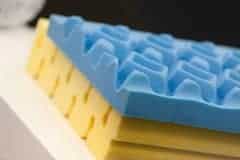
Surface modified Foams used in mattresses have many cuts and convolutions, not just to modify their comfort, but to aid in airflow.
Foamers looked for solutions. First, they adjusted closed-cell, visco-elastic foam formulas to make the product as open cell as standard polyurethane foam and latex foam. For example, foamer FXI describes its Aerus memory foam offering as “very open cell and very breathable.”
Next came heavy promotion of surface-modified foams. These are foam layers and cores with cuts, contours, channels and pinholing. The goal simply is to up the amount of airflow in each layer of the bed. As you go down into the bed’s high-density support core, there are channels and contours that act as mattress air vents.
Where once only latex was pinhole cored to adjust comfort levels, vertical and horizontal coring now is standard in many bed foams. Foamers such as Carpenter and Flexible Foam have invested in new boring machinery that can core individual foam components or entire mattress cores from top to bottom and laterally.
“We are seeing more and more requests for contour-cutting of foam than in the past—both for airflow and zoned comfort,” says Rick Anthony, director of sales for Hickory, N.C.-based HSM Bedding Solutions. “Channels in the foam can allow air to escape, but they are also a very visual point of differentiation and add interest.”
Nathan Elliott, marketing manager for Indianapolis-based fabricator Foamcraft, says, “We are doing so much with foam breathability through CNC surface modification technology. An advanced surface-modified design can be created for every foam layer, each with its own design and its own airflow rating.”
In 2012, some foamers began offering mattress makers foams that are strong, yet porous and netlike. Foamers recommend using reticulated foams close to the bed’s surface and even in the quilt layer.
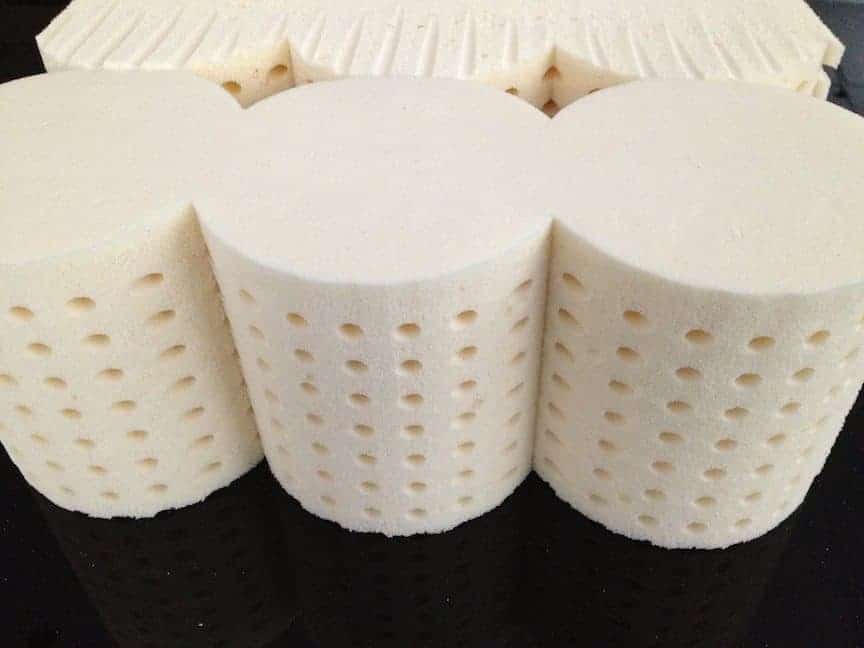
Rounded Latex International is creating layers of highly breathable latex in barrel shapes and cylinders to aid airflow through the mattress.
These reticulated-type foams were once reserved for things like outdoor furniture cushions, air filtration systems and stereo speakers. They have skeletal cell walls, an effect that is achieved via the foam’s chemical formulation in the pouring process or in a post-production process, involving either a chemical bath or putting the foam in a thermal reticulation chamber.
Anthony says that a ¾-inch layer of reticulated foam in a bed’s quilt “can literally wick the heat from the sleeper.” HSM introduced Preserve Hi Flo in 2013, a reticulated polyurethane foam produced via the foaming process.
FXI says its MaxPerm is a “true reticulated foam” produced via thermal reticulation in a chamber, a process the company has long used to produce highly permeable, yet durable, reticulated foams for a range of product categories.
Latex, too
Although latex typically is pinhole cored and open cell, latex suppliers, too, have retooled their offerings and are pouring latex foam into new shapes designed to offer an enhanced airflow story.
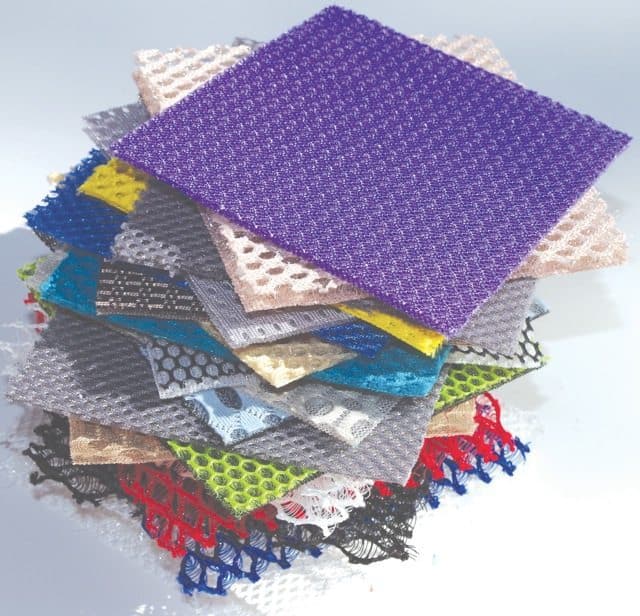
High loft “Three-dimensional ‘spacer fabrics’ are popular on mattress borders and panels as a way to improve air circulation through the bed,” says Scott Frisch, division president of textile supplier Springs Creative, which launched redesigned Airskin (pictured) in 2010, a large collection of spacer fabrics available in multiple designs and colors. “AirSkin has 20 times the air permeability of typical mattress fabrics,” Frisch says.
Natural latex supplier Arpico, a division of Richard Pieris Natural Foams Ltd. in Sri Lanka, offers Latex AirCell cores that are poured in one piece but have large vertical and lateral channels for maximum airflow.
Shelton, Conn.-based supplier Latex International has added latex layers with contoured profiles such as barrel shapes and horizontal cylinders.
Latexco, with world headquarters in Tielt, Belgium, created the Sonocore pouring process, which
it says yields an even more open-cell latex with uniform structure and excellent ventilation and temperature control.
Gel and gel foams
Since 2009, more and more mattresses sold to consumers, especially those marketed in Canada and the United States, have a gel foam or a poured gel component. (This gel component is different from buckling, pressure-threshold gel invented by Alpine, Utah-based EdiZone in 1997.)
The first gel foam offering was memory foam infused with gel particles or “beads.” Now, gel offerings include foams with swirled gels, as well as foams layered with poured gel.

Full of holes Porous, reticulated polyurethane foams can be used in the very top layer of the bed to wick away heat.
Gel has a higher density than foam and warms more slowly. Adding gel to the top comfort layer of a bed can provide an initial sensation of coolness to the sleeper, but whether gel offers an overall cooler night’s sleep is a matter of hot debate in the mattress industry. Gel is, however, proven to provide pressure relief and was first used in medical mattresses to help prevent pressure sores.
Phase-change craze
When gel is combined with phase-change material, there is science behind those cooling claims. Some of the newest offerings from foamers and latex suppliers are comfort layers studded with gel beads containing microencapsulated PCMs.
In 2012, Latex International created Talalay GL and Elite Foam launched Therma Phase Gel foams. Italian foamer Orsa Foam S.p.A. makes I-Foam Thermo, a polyurethane foam blended with “microspheres” of phase- change material.
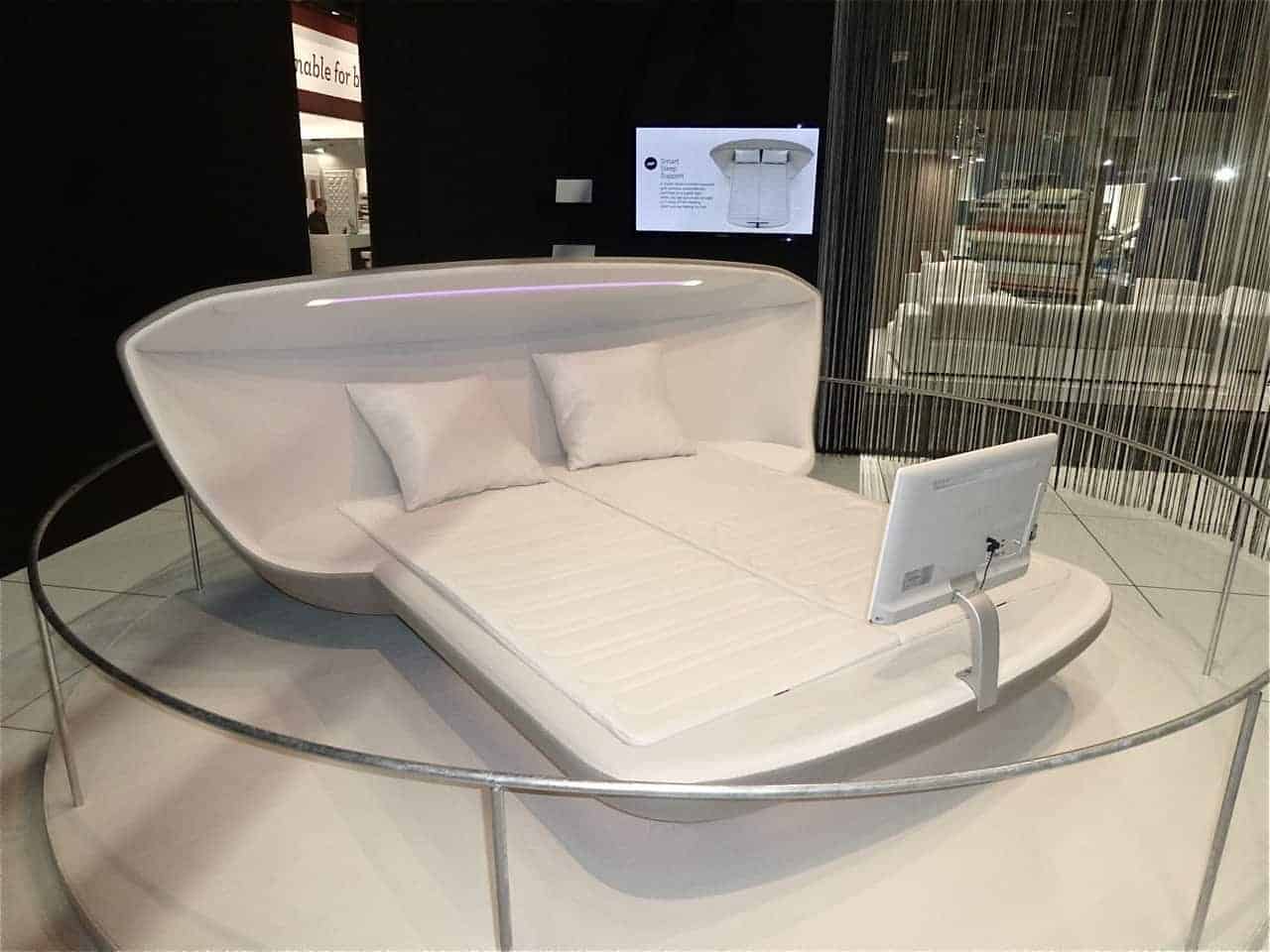
High tech DesleeClama’s Sleeping Tomorrow bed features a ticking that monitors the sleeper’s body temperature and, via embedded copper fiber and connectivity to a control panel and specialized software, is able to adjust a home’s heating and cooling system.
But what is phase-change material? PCMs are organic and inorganic compounds that store and release heat as they melt and solidify at certain temperatures. It is decades-old technology based on centuries-old thermodynamics research into the nature of “latent heat.” Also known as latent heat storage, phase-change material has applications in many industries, from building products to bedding.
Recently, mattress components suppliers have rolled out many new products that incorporate encapsulated PCM technology, giving mattress makers a broad choice when building beds with temperature-regulating features.
“Companies are becoming more innovative with the applications they use PCMs in — from fabrics to foams to gels and fill,” says Joe Wehrle, director of sales for microencapsulated PCM supplier Microtek Laboratories Inc., based in Dayton, Ohio. “The mattress marketplace is experiencing the cooling/warming effects that PCM technology provides, helping to create the ‘perfect sleep experience’ that end users value. Every day, new and inventive products are being introduced in the bedding segment which capitalize on the thermal benefits of phase-change materials.”
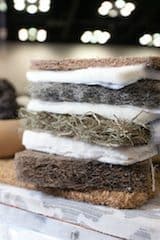
Get your fiber Foam beds can be layered with an array of natural or synthetic fiber pads to aid air circulation. This selection of coir, jute, sisal, wool and synthetic fiber is from Holland-based Enkev.
Latex suppliers and foamers are using phase-change material as a topical coating or blending it into their formulas. Latexco introduced topically coated Theta Comfort to the European market in 2011. In the United States and Canada, its topical PCM application is labeled as Thermic.
In 2012, foamer Carpenter Co. began applying Outlast phase-change technology to the surface of its finished foams — where, the company says, it is closest to the sleeper. Carpenter offers PCM coatings on most conventional polyurethane foams, as well as visco-elastic, used in the bed’s top upholstery layer.
Fabrics, first
Among component suppliers, textile companies have long been ahead of the pack when it comes to temperature-regulating innovation. Indeed, in recent years, suppliers have showcased some intriguing “smart fabrics” and concept beds that provide a high-tech glimpse at the future of sleep comfort.
One textile construction available for more than a decade but currently enjoying great popularity, especially on bed borders, is spacer fabric. Available in a range of heights, these airy 3D textiles are composed of two layers of fabric separated — and joined — by short vertical fibers that create a pathway for air circulation.
Ticking suppliers also offer (and were the first to market) phase-change material for bedding. In the 1990s, suppliers introduced woven, high-end fabrics made with Outlast yarns containing microencapsulated phase-change material.
Outlast Technologies LLC is a well-known supplier of PCM fibers, fabrics and coatings. The company’s Thermocule PCM technology is based on fabric and fiber research conducted by NASA in the 1980s that led to the development of temperature-controlled spacesuits and gloves for astronauts.
Most major ticking suppliers now knit or weave products with PCM fibers or coatings from Outlast or another PCM technology supplier. Belgium-based Devan Chemicals, represented in the United States by textile supplier Springs Creative, is the source of Latexco’s Thermic phase-change coating, and Springs Creative markets fabrics with the Thermic PCM coating.
While it hasn’t divulged any details, Belgium-based Bekaert launched Adaptive in 2013, a fabric treatment that “uses the heat of your body to boost moisture wicking, evaporation and cooling,” according to the company.
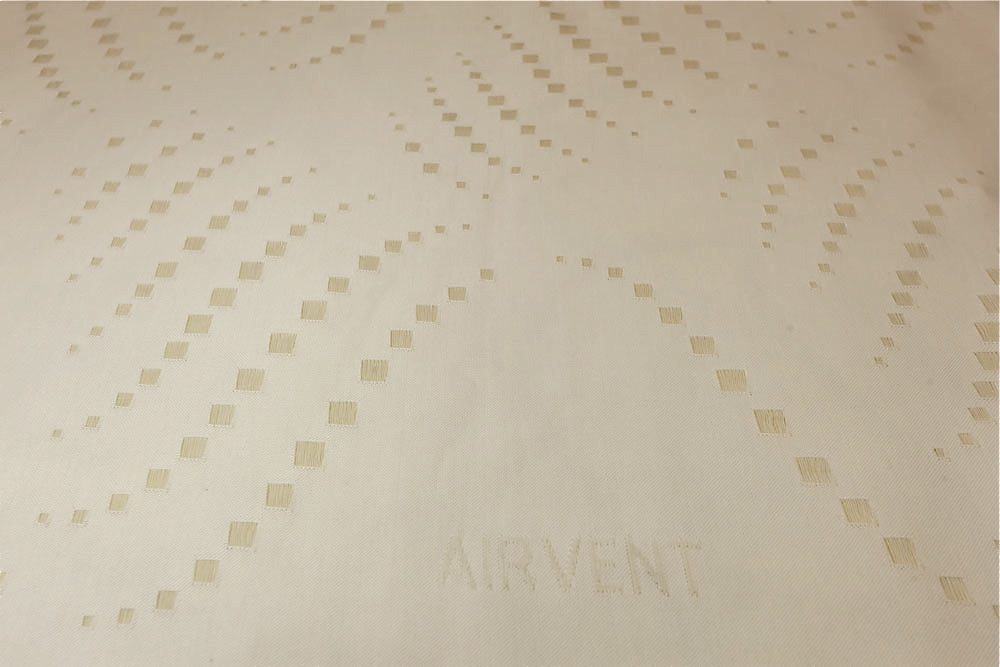
Window fabric AirVent by Innofa is mattress ticking with tiny portholes to help the bed’s core breathe.
Holland-based knit producer Innofa introduced something different in 2013. It added a premium knit ticking to its repertoire and won an Interzum Cologne award for Airvent. The knit has “air grids” or portholes incorporated into the knit design. The vents can be aligned with channels and perforations in the bed’s foam core.
Also at Interzum Cologne 2013, DesleeClama displayed the Sleeping Tomorrow bed with myriad features, including a ticking that monitors the sleeper’s body temperature and, via embedded copper fiber and connectivity to a control panel and specialized software, is able to adjust a home’s heating and cooling system.
Innersprings take on the improved airflow trend
When it comes to sleep temperature and airflow, springs suppliers enjoy touting the superiority of innerspring cores. In a 2013 BedTimes trend report on innersprings, suppliers said that one reason innerspring mattress sales around the globe are stronger than foam bed sales is because innerspring beds sleep cooler.
But even in innersprings, adjustments are being made to improve airflow. The popularity of fabric-wrapped coils or pocket springs in better bedding is a growing trend, especially in Europe and North America, and the typical coil wrapper is a breathable needle-punched nonwoven. But some innerspring suppliers are improving airflow with slitting and hole-punching.
U.K.-based Spinks Springs went a step further with Posturflo microcoils wrapped in a breezy, see-through mesh for maximum airflow, for which it won a 2013 Interzum Cologne award for high product quality and innovative design.
It’s electric!
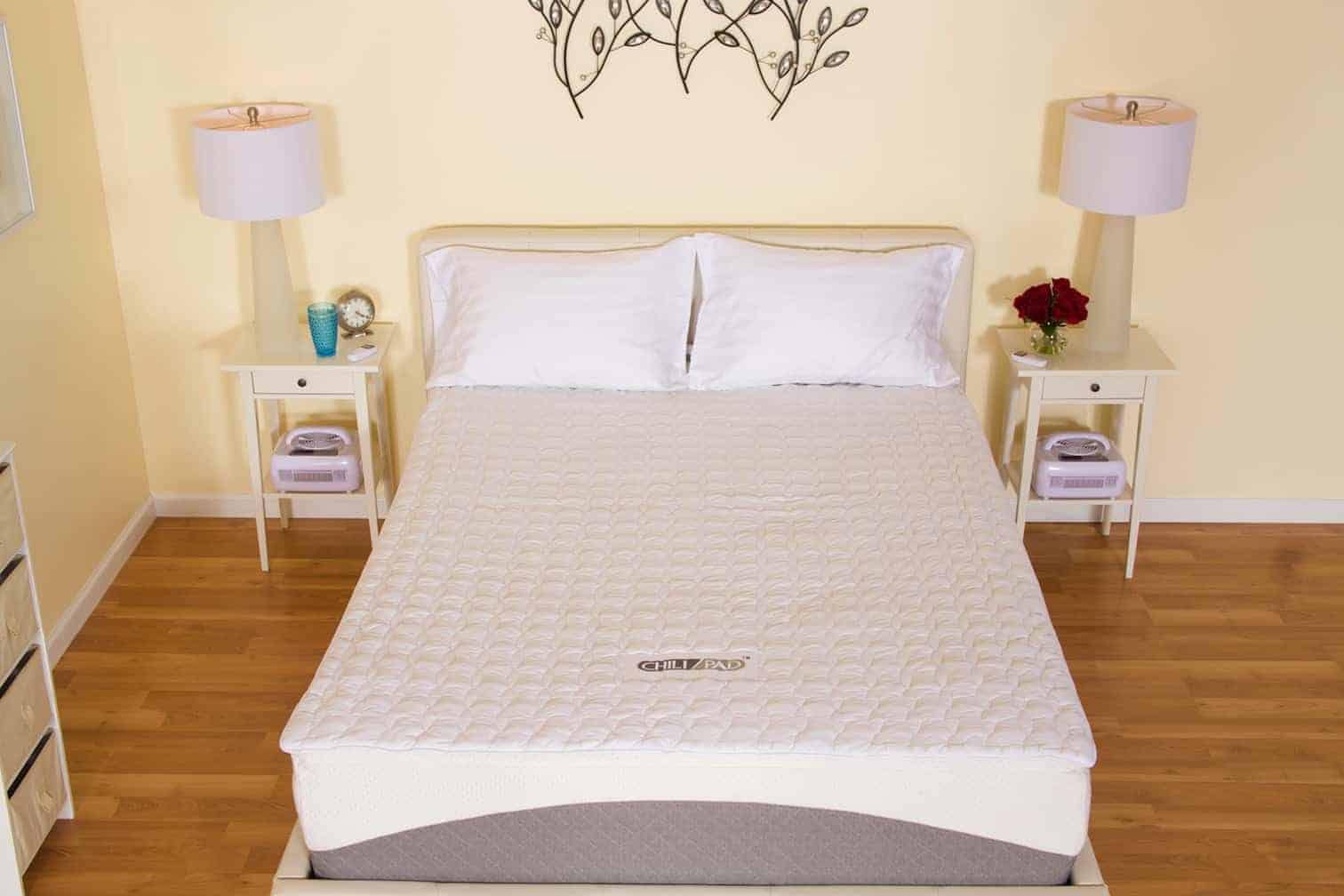
How cool is that? The ChiliPad from T2 International allows sleepers to cool down or warm up their side of the bed.
When sleep temperature is a major source of disagreement between sleep partners, there are solutions. A handful of mattress makers offer bed sets and toppers that allow sleepers to adjust their side of the bed to the perfect temperature.
Mooresville, N.C.-based Chili Technology LLC uses an electronic heating and cooling element integrated into its ChiliPad and, now, its ChiliBed, which launched in 2012. The technology allows users to adjust sleep surface temperatures from 60 degrees to 110 degrees. The product employs a closed-loop system with water that is heated and cooled as it circulates constantly through the topper or bed.
Coolness is the most desired feature, says Todd Youngblood, Chili Technology president.

It runs hot ‘n’ cold The Sleep Number DualTemp topper by airbed manufacturer Select Comfort warms and cools each side of the bed and has two programmable remotes. Photo credit: Select Comfort
“Consumers tell us, ‘You can’t make it cold enough for me. I’d sleep in a freezer if I could!’ “ he says. “We’ve gotten testimonials from people going through chemotherapy, menopausal women, couples who can finally sleep together comfortably — there’s so much enthusiasm and energy out there for this product.”
Other beds with electronic heating and cooling use an air system. Manufacturer and retailer Select Comfort introduced the heated and cooled Sleep Number DualTemp topper in 2013, using the company’s proprietary Active Air technology.
The YuMe bed, sold exclusively at Mattress Firm, has a solid-state heat pump with integrated convection to blow heated or cooled air through the sleep surface of the foam-core bed.




 There is no denying that foams play a popular and important role in today’s mattresses, whether as support core or as pressure-relieving comfort layers in the quilt panel and cushion.
There is no denying that foams play a popular and important role in today’s mattresses, whether as support core or as pressure-relieving comfort layers in the quilt panel and cushion.

